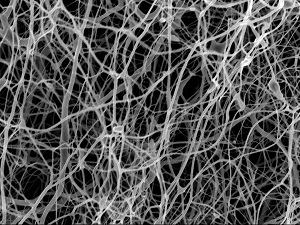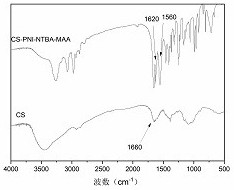Temperature-pH responsive molecularly-imprinted fiber membrane and preparation method thereof
A molecular imprinting and temperature-responsive technology, applied in fiber treatment, chemical instruments and methods, and other chemical processes, can solve the complex process of elution of template polymers, increase the cost of waste liquid treatment, and environmental friendliness, etc., to achieve rapid Short time for separation and polymerization, good stability
- Summary
- Abstract
- Description
- Claims
- Application Information
AI Technical Summary
Problems solved by technology
Method used
Image
Examples
Embodiment 1
[0028] Dissolve 1.01 g chitosan fiber membrane, 1.14 g isopropylacrylamide, 0.26 g tert-butylacrylamide, 0.61 g methacrylic acid, 0.02 g cuprous bromide and 0.02 g pentamethyldiethylenetriamine in 20.0 In mL deionized water, containing 0.2 g of the template dye gentian violet, nitrogen gas was bubbled for 60 min to remove oxygen in the environment. After reacting at 40.0 °C for 90 min, the fiber membrane was rinsed with ethanol for 3-6 times, and dried in vacuum for later use.
[0029]The 13 mg fiber membrane was immersed in 43 mL gentian violet solution with an initial concentration of 20 mg / L, the pH was 7.0, and the adsorption capacity was measured to be 212.0 mg / g after adsorption equilibrium for 7 minutes. The fiber membrane adsorbed with gentian violet was transferred to a (20 mL, 36.5 g / L) hydrochloric acid aqueous solution at a pH of 3.0 and a temperature of 25 °C. Then the temperature was rapidly raised to 60°C, maintained for 30 min, and then rapidly lowered to 25°C...
Embodiment 2
[0031] Dissolve 1.01 g chitosan fiber membrane, 1.14 g isopropylacrylamide, 0.26 g tert-butylacrylamide, 0.61 g methacrylic acid, 0.02 g cuprous bromide and 0.02 g pentamethyldiethylenetriamine in 20.0 In mL deionized water, containing 0.2 g of the template dye gentian violet, nitrogen gas was bubbled for 60 min to remove oxygen in the environment. After reacting at 40.0 °C for 90 min, the fiber membrane was rinsed with ethanol for 3-6 times, and dried in vacuum for later use.
[0032] The 13 mg fiber membrane was immersed in 43 mL gentian violet solution with an initial concentration of 20 mg / L, the pH was 7.0, and the adsorption capacity was measured to be 196.0 mg / g after adsorption equilibrium for 7 minutes. The fiber membrane adsorbed with gentian violet was transferred to a (20 mL, 36.5 g / L) aqueous hydrochloric acid solution at a pH of 3.0 and a temperature of 25 °C. Then the temperature was rapidly raised to 60°C, maintained for 30 min, and then rapidly lowered to 25°...
Embodiment 3
[0034] Dissolve 1.01 g chitosan fiber membrane, 1.14 g isopropylacrylamide, 0.26 g tert-butylacrylamide, 0.61 g methacrylic acid, 0.02 g cuprous bromide and 0.02 g pentamethyldiethylenetriamine in 20.0 In mL deionized water, containing 0.2 g of the template dye gentian violet, nitrogen gas was bubbled for 60 min to remove oxygen in the environment. After reacting at 40.0 °C for 90 min, the fiber membrane was rinsed with ethanol for 3-6 times, and dried in vacuum for later use. Electron microscope test results show that the fibers are uniform and have high porosity.
[0035] The 13 mg fiber membrane was immersed in 43 mL gentian violet solution with an initial concentration of 20 mg / L, the pH was 7.0, and the adsorption capacity was measured to be 177.0 mg / g after adsorption equilibrium for 7 minutes. The fiber membrane adsorbed with gentian violet was transferred to a (20 mL, 36.5 g / L) aqueous hydrochloric acid solution at a pH of 3.0 and a temperature of 25 °C. Then the tem...
PUM
| Property | Measurement | Unit |
|---|---|---|
| adsorption capacity | aaaaa | aaaaa |
| adsorption capacity | aaaaa | aaaaa |
| adsorption capacity | aaaaa | aaaaa |
Abstract
Description
Claims
Application Information
 Login to View More
Login to View More - R&D
- Intellectual Property
- Life Sciences
- Materials
- Tech Scout
- Unparalleled Data Quality
- Higher Quality Content
- 60% Fewer Hallucinations
Browse by: Latest US Patents, China's latest patents, Technical Efficacy Thesaurus, Application Domain, Technology Topic, Popular Technical Reports.
© 2025 PatSnap. All rights reserved.Legal|Privacy policy|Modern Slavery Act Transparency Statement|Sitemap|About US| Contact US: help@patsnap.com


